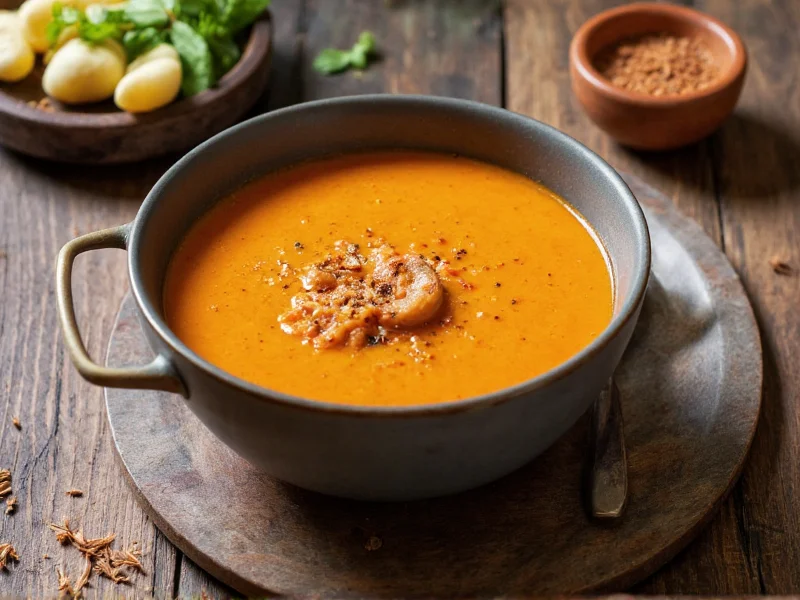Understanding the precise definition of a soup helps both home cooks and culinary professionals create authentic dishes that meet traditional expectations. While soup variations exist across cultures and cuisines, certain fundamental elements consistently define what makes a dish qualify as soup rather than another type of preparation.
Core Characteristics of Soup
At its most basic level, soup requires three essential components: a liquid base, solid ingredients, and a cooking method that allows flavors to meld. The liquid component—typically water, stock, or broth—must constitute the majority of the dish's volume. This liquid base differentiates soup from sauces, which are designed to complement other foods rather than serve as the primary dish.
Unlike stews, which maintain a thicker consistency with less liquid and larger ingredient pieces, soup generally has a higher liquid-to-solid ratio. The cooking process for soup typically involves simmering ingredients together, allowing flavors to blend while maintaining the integrity of the individual components.
Historical Evolution of Soup
Soup has been a dietary staple for millennia, with archaeological evidence suggesting early humans created primitive soups by heating water in animal skins or hollowed logs. The word "soup" derives from the Old French "soupe," which referred to bread soaked in broth. In medieval times, soup was often called "pottages"—thick, one-pot meals cooked slowly over fire.
The modern definition of soup began taking shape during the 18th century when French chefs developed clear consommés and refined broth-based preparations. This culinary evolution established the distinction between clear soups (like consommé) and thick soups (like bisques and purees) that remains relevant in contemporary culinary classification.
Soup Classification System
Chefs and food scientists categorize soups based on their preparation method and final texture. The following table outlines the primary soup classifications:
| Soup Category | Characteristics | Common Examples |
|---|---|---|
| Clear Soups | Transparent broth with visible ingredients | Consommé, bouillon, broth |
| Thick Soups | Opaque with higher viscosity | Bisque, chowder, puree |
| Specialty Soups | Unique preparation methods | Minestrone, gumbo, pho |
| Cold Soups | Served chilled | Gazpacho, vichyssoise |
Distinguishing Soup from Similar Preparations
Many food enthusiasts wonder about the difference between soup and stew. While both involve cooking ingredients in liquid, stews contain less liquid and feature larger ingredient pieces that maintain their shape throughout cooking. Stews typically require longer cooking times at lower temperatures, resulting in a thicker final product that's often served as a complete meal.
Similarly, the soup vs broth vs consommé distinction centers on preparation and clarity. Broth serves as the base for many soups but lacks the additional ingredients that transform it into a complete soup. Consommé represents a refined broth that's been clarified to achieve exceptional transparency while maintaining rich flavor.
Scientific Perspective on Soup Definition
From a food science perspective, soup qualifies as a heterogeneous mixture where solid components remain suspended in a liquid medium. The ideal soup maintains a specific viscosity range—typically between 1-10 centipoise—which allows ingredients to remain suspended without settling too quickly. This scientific definition of soup helps food manufacturers create consistent products that meet consumer expectations.
Temperature also plays a crucial role in the soup experience. While most soups are served hot (between 160-180°F or 71-82°C), certain cultural traditions feature cold soups that provide refreshing alternatives during warmer months. The serving temperature significantly impacts flavor perception and overall dining experience.
Cultural Variations in Soup Definition
Cultural contexts influence how different societies define and categorize soup. In Japanese cuisine, miso soup represents a fundamental component of traditional meals, while in French culinary tradition, soup often serves as the first course. These cultural variations demonstrate how the basic culinary definition of soup adapts to local ingredients and dining customs.
Some cultures maintain stricter definitions than others. For instance, Chinese cuisine distinguishes between tang (clear soups) and geng (thickened soups), while Mexican cuisine features complex preparations like pozole that blur the line between soup and stew. Understanding these cultural nuances enriches our appreciation of global soup traditions.
Common Misconceptions About Soup
Several misconceptions persist about what constitutes a proper soup. One common misunderstanding suggests that all soups must contain meat or animal products, when in fact countless vegetarian and vegan soups exist worldwide. Another misconception claims that soup must be served hot, ignoring traditional cold soup preparations like Spanish gazpacho.
Perhaps the most persistent myth involves the what makes a soup a soup question. Some believe that any liquid food qualifies as soup, but culinary professionals recognize that items like smoothies, milkshakes, and even some sauces don't meet the technical definition due to their preparation methods and intended consumption.
Practical Applications of Soup Knowledge
Understanding the precise definition of soup offers practical benefits for home cooks and culinary professionals. When following recipes, recognizing whether a preparation qualifies as soup helps determine appropriate cooking techniques, ingredient ratios, and serving methods. This knowledge proves particularly valuable when adapting traditional recipes to modern dietary preferences or constraints.
For food writers and recipe developers, accurate classification ensures proper categorization that helps consumers find relevant dishes. Culinary students benefit from understanding these distinctions as they develop foundational cooking skills and learn to create balanced, authentic preparations.











 浙公网安备
33010002000092号
浙公网安备
33010002000092号 浙B2-20120091-4
浙B2-20120091-4